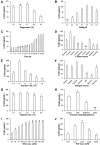Probiotic Properties and Optimization of Gamma-Aminobutyric Acid Production by Lactiplantibacillus plantarum FBT215
- PMID: 35586927
- PMCID: PMC9628908
- DOI: 10.4014/jmb.2204.04029
Probiotic Properties and Optimization of Gamma-Aminobutyric Acid Production by Lactiplantibacillus plantarum FBT215
Abstract
Gamma-aminobutyric acid (GABA) improves various physiological illnesses, including diabetes, hypertension, depression, memory lapse, and insomnia in humans. Therefore, interest in the commercial production of GABA is steadily increasing. Lactic acid bacteria (LAB) have widely been reported as a GABA producer and are safe for human consumption. In this study, GABA-producing LAB were preliminarily identified and quantified via GABase assay. The acid and bile tolerance of the L. plantarum FBT215 strain were evaluated. The one-factor-at-a-time (OFAT) strategy was applied to determine the optimal conditions for GABA production using HPLC. Response surface methodology (RSM) with Box-Behnken design was used to predict the optimum GABA production. The strain FBT215 was shown to be acid and bile tolerant. The optimization of GABA production via the OFAT strategy resulted in an average GABA concentration of 1688.65 ± 14.29 μg/ml, while it was 1812.16 ± 23.16 μg/ml when RSM was applied. In conclusion, this study provides the optimum culture conditions for GABA production by the strain FBT215 and indicates that L. plantarum FBT215 is potentially promising for commercial functional probiotics with health claims.
Keywords: Gamma-aminobutyric acid; Lactiplantibacillus plantarum; one-factor-at-a-time strategy; optimization; probiotic properties; response surface methodology.
Conflict of interest statement
The authors have no financial conflicts of interest to declare.
Figures




Similar articles
-
Probiotic attributes, antioxidant and neuromodulatory effects of GABA-Producing Lactiplantibacillus plantarum SY1 and optimization of GABA production.BMC Microbiol. 2025 May 29;25(1):341. doi: 10.1186/s12866-025-04070-9. BMC Microbiol. 2025. PMID: 40442580 Free PMC article.
-
Gamma-aminobutyric acid fermentation in MRS-based medium by the fructophilic Lactiplantibacillus plantarum Y7.Food Sci Biotechnol. 2022 Feb 8;31(3):333-341. doi: 10.1007/s10068-022-01035-w. eCollection 2022 Mar. Food Sci Biotechnol. 2022. PMID: 35273823 Free PMC article.
-
Improvement of ɣ-Aminobutyric Acid Production and Cell Viability of Lactiplantibacillus plantarum B7 via Whole-Cell Immobilisation in Repeated Batch Fermentation System.Probiotics Antimicrob Proteins. 2024 Dec;16(6):1907-1924. doi: 10.1007/s12602-023-10200-4. Epub 2023 Dec 12. Probiotics Antimicrob Proteins. 2024. PMID: 38085437
-
Biosynthesis of Gamma-Aminobutyric Acid (GABA) by Lactiplantibacillus plantarum in Fermented Food Production.Curr Issues Mol Biol. 2023 Dec 26;46(1):200-220. doi: 10.3390/cimb46010015. Curr Issues Mol Biol. 2023. PMID: 38248317 Free PMC article. Review.
-
Production of Gamma-Aminobutyric Acid from Lactic Acid Bacteria: A Systematic Review.Int J Mol Sci. 2020 Feb 3;21(3):995. doi: 10.3390/ijms21030995. Int J Mol Sci. 2020. PMID: 32028587 Free PMC article.
Cited by
-
Ligilactobacillus Salivarius improve body growth and anti-oxidation capacity of broiler chickens via regulation of the microbiota-gut-brain axis.BMC Microbiol. 2023 Dec 9;23(1):395. doi: 10.1186/s12866-023-03135-x. BMC Microbiol. 2023. PMID: 38071295 Free PMC article.
-
Genome-wide transcriptomics revealed carbon source-mediated gamma-aminobutyric acid (GABA) production in a probiotic, Lactiplantibacillus pentosus 9D3.Heliyon. 2025 Jan 10;11(2):e41879. doi: 10.1016/j.heliyon.2025.e41879. eCollection 2025 Jan 30. Heliyon. 2025. PMID: 39897778 Free PMC article.
-
Synbiotic Fermentation of Undaria pinnatifida and Lactobacillus brevis to Produce Prebiotics and Probiotics.Appl Biochem Biotechnol. 2023 Oct;195(10):6321-6333. doi: 10.1007/s12010-023-04415-y. Epub 2023 Mar 2. Appl Biochem Biotechnol. 2023. PMID: 36862333
-
Isolation and optimization of Bacillus thuringiensis BRB-3 isolated from germinated black upland rice seeds for GABA production.Heliyon. 2025 Jan 11;11(3):e41884. doi: 10.1016/j.heliyon.2025.e41884. eCollection 2025 Feb 15. Heliyon. 2025. PMID: 39916844 Free PMC article.
-
Hybrid substrate-based pH autobuffering GABA fermentation by Levilactobacillus brevis CD0817.Bioprocess Biosyst Eng. 2024 Dec;47(12):2101-2110. doi: 10.1007/s00449-024-03088-z. Epub 2024 Sep 13. Bioprocess Biosyst Eng. 2024. PMID: 39269502
References
-
- Tsai JS, Lin YS, Pan BS, Chen TJ. Antihypertensive peptides and γ-aminobutyric acid from prozyme 6 facilitated lactic acid bacteria fermentation of soymilk. Process Biochem. 2006;41:1282–1288. doi: 10.1016/j.procbio.2005.12.026. - DOI
MeSH terms
Substances
LinkOut - more resources
Full Text Sources
Other Literature Sources
Molecular Biology Databases
Miscellaneous

